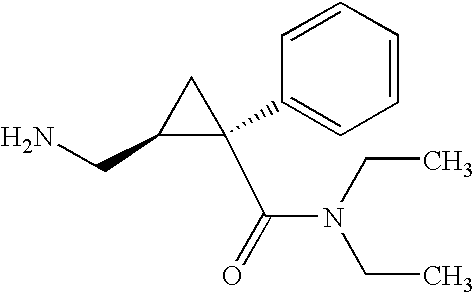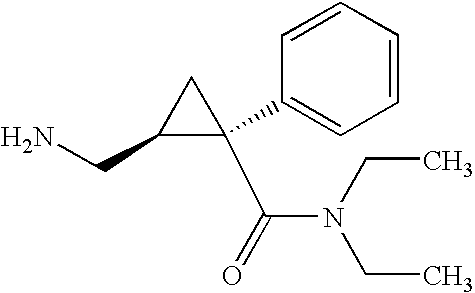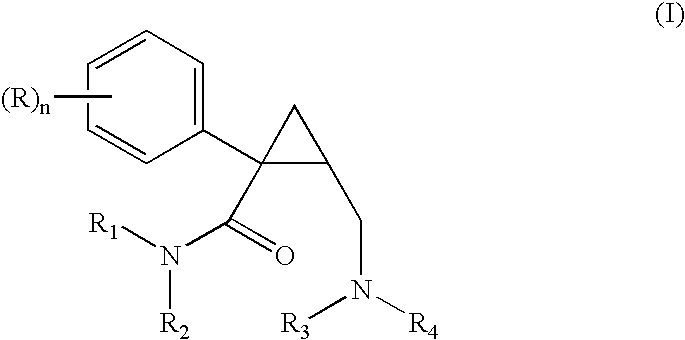Methods of treating attention deficit/hyperactivity disorder (adhd)
a technology of attention deficit/hyperactivity disorder and treatment method, applied in the field of methods, can solve the problems of insomnia and appetite reduction, significant number of adults affected, and serious side effects of drugs in some patients,
- Summary
- Abstract
- Description
- Claims
- Application Information
AI Technical Summary
Benefits of technology
Problems solved by technology
Method used
Image
Examples
example 1
Assessment of the Efficacy of Milnacipran in an Animal Model of AD / HD
[0203] In this study, spontaneously hypertensive rats (SHR) are used as an animal model for AD / HD. The SHR animal model is described in Russell et al., 2000, Behavioral Brain Research, 117: 69-74; Russell, 2001, Metab. Brain Dis., 16: 143-149; and Sagvolden et al., 1992, Behav. Neural Biol., 58: 103-112. The study consists of two groups of rats: normal and SHR. Each group is further divided into two subgroups: placebo and milnacipran. The milnacipran subgroup is further divided into four subgroups and each subgroup is administered 5, 10, 25, or 50 mg / kg of milnacipran. The milnacipran is administered to the rats over a period of twenty-one days.
[0204] The rats are from the normal and SHR groups are trained in the delayed gratification response paradigm as described in Charrier et al., 1996, Pharmacology and Biochemistry and Behavior, 54: 149-157. In this paradigm, rats learn to choose between five food pellets de...
example 2
Assessment of the Efficacy of Milnacipran in an Animal Model of Tic Disorder
[0206] The rats described in McGrath et al., 2000, Brain Research, 877: 23-30, are used to study the effects of milnacipran on tic disorders. The rats are divided into two groups: placebo and milnacipran. The milnacipran group is further divided into four subgroups and each subgroup is administered 5, 10, 25, or 50 mg / kg of milnacipran. The milnacipran is administered to the rats over a period of twenty-one days.
[0207] Abnormal behavior, specifically tic-like behavior are quantified before and after administration of milnacipran. Administration of milnacipran reduces the abnormal behavior such as climbing / leaping, gnawing, and other tic-like behaviors.
example 3
Assessment of the Efficacy of Milnacipran in Patients with AD / HD and Comorbid Tic Disorder
[0208] This study is a randomized, double-blind, placebo-controlled trial of parallel groups. After the screening procedures and a 14-day washout period, the subjects are randomly assigned to receive either milnacipran or placebo for 8 weeks.
[0209] Before entry into the study, each patient undergoes a detailed clinical evaluation by a psychiatrist and / or a psychologist. The diagnosis of AD / HD and comorbid tic disorder is made on the basis of this interview.
[0210] Entry criteria includes age between 7 and 15 years, a DSM-IV diagnosis of AD / HD (any type), a DSM-IV tic disorder (any type), and a score of ≧1.5 standard deviation units for age and gender on the 10-item Conners hyperactivity index (Goyette et al., 1978, J. Abnorm. Child Psychol., 6: 221-236) rated by a teacher or parent.
[0211] Exclusion criteria includes evidence of major depression, generalized anxiety disorder, separation anxie...
PUM
| Property | Measurement | Unit |
|---|---|---|
| Molar density | aaaaa | aaaaa |
| Molar density | aaaaa | aaaaa |
| Molar density | aaaaa | aaaaa |
Abstract
Description
Claims
Application Information
 Login to View More
Login to View More - R&D
- Intellectual Property
- Life Sciences
- Materials
- Tech Scout
- Unparalleled Data Quality
- Higher Quality Content
- 60% Fewer Hallucinations
Browse by: Latest US Patents, China's latest patents, Technical Efficacy Thesaurus, Application Domain, Technology Topic, Popular Technical Reports.
© 2025 PatSnap. All rights reserved.Legal|Privacy policy|Modern Slavery Act Transparency Statement|Sitemap|About US| Contact US: help@patsnap.com



